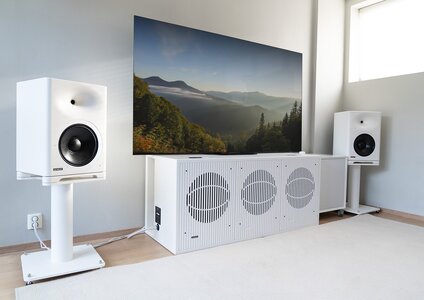Subject: Bookshelf vs Floorstanders – No Contest in My Experience
Dear fellow Hi-Fi enthusiasts,
I’ve been reflecting on the age-old debate between bookshelf (or standmount) speakers and full-sized floorstanders, and I’d like to share my experience—perhaps to spark some friendly discussion.
In my opinion, there’s simply no substitute for what floorstanders can do, especially when it comes to low frequencies, scale, and sheer presence. No matter how well-engineered a small speaker might be, I don’t believe it can truly match the full-bodied sound, room-filling capability, and effortless bass extension of a large loudspeaker.
I own and have lived with both types. As much as I appreciate the clarity and precision of small monitors like the Dynaudio Emit 10 and KEF bookshelf models, I can’t help but feel like I’m giving them a kind of "death sentence" when I hook them up to serious amplification—such as my Yamaha C-3 preamp and M-4 power amp. These amps deserve a proper load to drive, and so do the recordings.
When I connect my Tannoy Cheviots (with 12” Gold drivers, weighing 30 kilos each) or my Dynaudio Audience 70 floorstanders, the system breathes. The music comes alive with weight, authority, and presence. The small speakers simply can’t compete in that department—at least not in a medium to large-sized room and certainly not at realistic listening levels.
Of course, not everyone has the space or budget for large speakers, and that’s fair. But it’s a shame that nowadays, many truly substantial speakers seem to be reserved for the wealthy few. Good furniture-grade cabinets, proper drivers, and hefty build quality are costly to produce—and it shows.
I’d be interested to hear what others think. Have you made the switch one way or the other? And if you prefer standmounts, do you feel you're giving anything up in terms of scale or bottom-end realism?
Warm regards,
Reginald Mintoff
(Malta)
Dear fellow Hi-Fi enthusiasts,
I’ve been reflecting on the age-old debate between bookshelf (or standmount) speakers and full-sized floorstanders, and I’d like to share my experience—perhaps to spark some friendly discussion.
In my opinion, there’s simply no substitute for what floorstanders can do, especially when it comes to low frequencies, scale, and sheer presence. No matter how well-engineered a small speaker might be, I don’t believe it can truly match the full-bodied sound, room-filling capability, and effortless bass extension of a large loudspeaker.
I own and have lived with both types. As much as I appreciate the clarity and precision of small monitors like the Dynaudio Emit 10 and KEF bookshelf models, I can’t help but feel like I’m giving them a kind of "death sentence" when I hook them up to serious amplification—such as my Yamaha C-3 preamp and M-4 power amp. These amps deserve a proper load to drive, and so do the recordings.
When I connect my Tannoy Cheviots (with 12” Gold drivers, weighing 30 kilos each) or my Dynaudio Audience 70 floorstanders, the system breathes. The music comes alive with weight, authority, and presence. The small speakers simply can’t compete in that department—at least not in a medium to large-sized room and certainly not at realistic listening levels.
Of course, not everyone has the space or budget for large speakers, and that’s fair. But it’s a shame that nowadays, many truly substantial speakers seem to be reserved for the wealthy few. Good furniture-grade cabinets, proper drivers, and hefty build quality are costly to produce—and it shows.
I’d be interested to hear what others think. Have you made the switch one way or the other? And if you prefer standmounts, do you feel you're giving anything up in terms of scale or bottom-end realism?
Warm regards,
Reginald Mintoff
(Malta)


